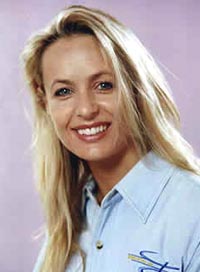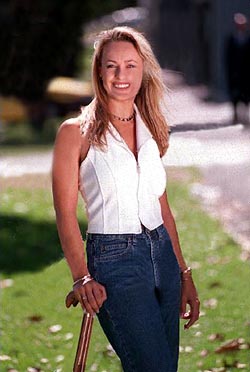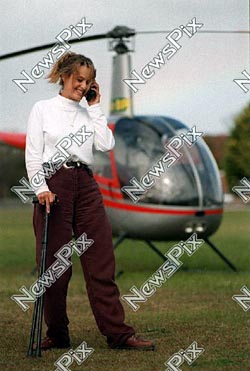
|
|
Allana's amazing aerial adventure Pilot Allana Arnot yesterday completed the last leg of a 21,000km journey around Australia in her tiny helicopter that she fondly calls elf. Her immediate plans were to hug the men that saved her life nearly seven years ago, change her boots, put on new clothes and get her hair trimmed. Later down the track she will write a book on her life experiences and try to obtain media work using little elf for promotional events.
Allana, then 23, was a passenger on a single-engine Cessna 210 which was one of 13 aircraft assisting the Civil Aviation Authority in a search for the wreckage of another plane. She was airlifted from the disaster scene by a Westpac Lifesaver Helicopter team and taken to hospital where she spent the next three months recovering. Nine months after the accident she was flying once again as a passenger. Then she went one step further and got behind the controls of a helicopter. "I was terrified the first time I flew after the accident," she said. "I remember saying to myself something along the lines of 'what on earth am I doing up here?'."Allana said she used to be paranoid about crashing but since had calmed her fears through repeated flying stints and determination. "Every pilot is aware of what can go wrong and you have to fly with a great respect," she said. "If the craft is well maintained and you don't do stupid things or fly beyond your means then it's relatively safe."Allana, of Cronulla, has spent the past 48 days in the air during her first journey around Australia. She was accompanied by three other helicopters. "The basic line we followed was Australia on the left and ocean on the right," she said.Allana called into Wollongong on Tuesday afternoon during the last leg of the journey. She stayed overnight, refuelled elf and flew back to the Westpac Lifesaver base at Prince Henry Hospital yesterday morning to make a presentation to the vital emergency service. At the base she was reunited with part of the crew that rescued her in 1990.
The strong-willed woman said she never tired of flying during the marathon flight but had the occasional cramped knee, hip or bottom after flying for long periods. She laughed when asked what she was going to do now that life was back to normal. "What's normal?" she wondered aloud. "I have always had a passion for flying. It's my life."
Allana Arnot's aviation career began in 1988 when she began working for Balloon Aloft as ground crew & tourist marketing. Allana also began fixed-wing training & skydiving at this time. On 22nd December, 1990, Allana was crew on a Search & Rescue mission from Camden Airport despatched to locate a missing training aircraft. The plane Allana was in - a Cessna 210 - suffered a catastrophic engine failure & crashed in the Burrogorang Valley. There were only 2 survivors out of the six crew.
Allana's comeback has been described as miraculous - not only has she taught herself to walk again but in 1995, she gained her commercial helicopter licence & in 1997, became the first woman to circumnavigate Australia solo in a helicopter. In October, 1998, Allana launched her autobiography The Best I Can Be published by Pan MacMillan & is currently writing her second commissioned book. Today Allana enjoys her commitments on the public speaking circuit, working extensively with many charity organisations promoting & fund-raising while continuing to support the helicopter rescue services. Allana is ambassador for the Ability Australia Foundation & is a part-time helicopter pilot for Rotor-Lift Helicopters based in Hobart. In 2000, Allana helped establish the Tasmanian Air Rescue Trust, a charity set up to equip Tasmania's Police Rescue Helicopter with the highest standard of medical and rescue equipment. The Trust also ensures that Tasmania's community can expect the best service from its Rescue Helicopter and its extensively trained pilots and crew at all times. Allana currently works to raise funds for the Trust and promote Tasmania's Air Rescue Service around the state.
SES Gazette : Rotor-Lift Staff Profile : Allana Arnot Next in line for our profile is Allana Arnot, the more Public face of Rotor-Lift. Allana's aviation career started in 1988 when she was working as ground crew for a company called Balloon Aloft. While working for Balloon Aloft, Allana began fixed-wing training and skydiving.
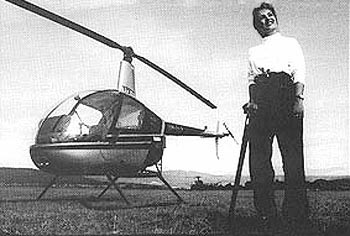
Allana Arnot Two years later on 22 December 1990, Allana's life would change forever. When on a search for a small training aircraft, the Cessna 210 that she was crewing with five others suffered major engine failure, crashing in bushland in the Burrograng Valley. Out of the six crew, only two survived. Allana was flown to Prince Henry Hospital by the Sydney-based Westpac Rescue helicopter. Among other injuries, Allana had a broken back and was told she would never walk again. If you have ever met Allana, telling her that she cannot do something is not the wisest thing to do. Not only did Allana teach herself to walk again, but in 1995 she gained her commercial helicopter licence. In 1997, she became the first woman to circumnavigate Australia solo in a helicopter. In 1998, Allana launched her autobiography called The Best I Can Be. I would recommend this book to anybody; it is one of the best books I have read in a long time. Allana is currently writing her second book and hopes to have it published later this year. I have worked with Allana seven or eight times over the past months and will be working with her more in the months to come. I enjoy working with her as she makes you stop and think, that no matter what life puts in your way, you should always follow your dreams. A poem at the beginning of Allana's book is the end of my profile on a remarkable woman.
For if dreams die Life is like a broken-winged bird That cannot fly.'
Amazing Allana Arnot Circumnavigates Australia Just seven years ago, Allana Arnot was seriously injured in an airplane accident. She wasn't expected to walk again, but this year she flew an R22 solo around her native country of Australia. What follows is Allana's own inspirational history of strength, determination and courage. Dear Mr. Robinson, I feel compelled to write to you as the owner of one of your R22 helicopters. Last month, I completed an enormous challenge to circumnavigate Australia solo in my helicopter VH-ELF. There were a total of four R22 helicopters that completed the trip flying in convoy around our country. This probably doesn't sound like earth-shattering news to you, but I would like to explain why this trip meant so much to me.
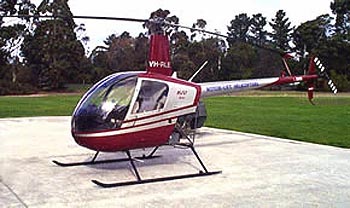
Robinson R22, Rotor-Lift Helicopters Robinson R22 VH-RLE; Engine Type: Lycoming; Engine Power (HP): ; Fuel Capacity (It's): 112 Litres; Cruise Speed (kph): 100 kph.; Payload (Kgs): 162kg.; Seating Capacity (Excluding Pilot): 1 person; Range (Km) with full payload: 450km.; Endurance (hrs/min) with full payload: 3hrs 12mins.; Night VFR: Yes; GPS-Make/Model: Garmin 100; Mobile Phone: Nokia 5110I have been involved in aviation since 1987 and enjoyed not only fixed wing flying but ballooning and skydiving. Flying is a passion that my husband Nigel, and I both share. On 21st December, 1990, a Cessna 152 went out on a training flight from our base airfield at Camden, New SouthWales, but didn't return. The next day, I was allocated to be an observer on a search and rescue flight as efforts to find the missing plane continued. Almost an hour into the flight our Cessna 210 suffered a catastrophic engine failure, we were forced to put down in extremely treacherous terrain. Four people died that day, and I was left paraplegic with serious spinal damage among numerous other injuries. I was not expected to walk again, and my pilot's license was revoked until I could pass a medical; this was also not expected. I spent the next three months in hospital and a furthet twelve months confined to a wheel chair, but am proud to say that after a lot of hard work, I am back on my feet and walking with the aid of two walking sticks and supports on my lower legs that hold my feet at 90 degrees. These supports are required because as a result of the impact during the crash, the base of my spinal chord was torn apart and the spine had been badly broken. The resulting paralysis mean that I have absolutely no feeling or movement from my knees down, and only my quadriceps work properly in my upper legs. My walking gait is awkward and ungainly. After some time, I felt the need to fly again, so with Nigel's help, I tried some circuits. The input required to operate the rudder pedals proved no problem, but I couldn't push the toe brakes to stop on the runway. My only option was to rave an aeroplane modified with a hand brake which I chose not to do. Helicopters held a fascination for me for some time. I thought that maybe I could cope with the tail rotor pedals. I booked a trial flight at a school and flew my first R22. The freedom was amazing; it was obvious from that moment that this was for me. During my training (through trial and error), I discovered that the most successful position for my feet was up of the floor with the tail rotor pedal resting in the heel of my shoe, so footwear is very important when I fly. The other interesting consideration was that I could not get feedback from the helicopter, I couldn't really feel what the aircraft was doing through my legs, so other senses took over (sight and sound). The delicate control inputs took some time to sort out because not only can I not feel outside forces on my legs, but I cannot feel what my legs are doing. Needless to say. everything fell into place, because I completed my commercial license in February 1996. Later that year, I went looking for a second hand R22 to purchase and found one in Arizona. The helicopter was shipped to Australia and I flew it first in January 1997. I had dreamt of flying around Australia in a helicopter for some time and was lucky to find three other pilots who shared this dream. We all owned our own R22 helicopters, so on 7th June this year we set off 'on our epic joumey. I chose to begin the trip from the West-pac rescue helicopter base in Sydney. This meant a lot to me because these were the people who saved my life when they pulled me out of the aeroplane wreck; it was fitting to start and finish the kip there. The group of four helicopters and six crew were known as "Robinsons Around Australia." We tracked coastal anticlockwise for the entire 21,000 km (12,600 miles) and approximately 165 flying hours each, which took six weeks and four days to complete. We flew our helicopters through rain, in 35+ knot winds, through dust, turbulence and through extemely desolate areas. We landed on sand, in bush scrub and of uneven rock shelves. (Allana flew alone without a passenger, but her helicopter was heavily loaded with the supplies and equipment the others couldn't carry.) Many times throughout the trip especially when flying through severe turbulence, we would thank you, Mr Robinson, for designing and building such a strong and reliable machine. It is a comfort to me to have such confidence in the helicopter I am flying having already survived an aircraft crash. It is pleasing to know (but not surprising) that in 165 flying hours, through adverse conditions, each of the four "Robinsons Around Australia" completed the journey without one single hiccup, nothing at all went wrong and for that we do thank you for building such a fantastic helicopter. The purpose of this letter is to thank you for your Robinson helicopter - when I am flying I can escape from the restrictions I feel on the ground, walking for me is tiring, painfulll and extremely diflicult but when I am in the air, I have complete fieedom. I simply love to fly my helicopter. Kind regards, Allana Arnot
There are two Allana Arnots. Matt Condon meets the one who survived a plane crash. You can't help but think about life, the universe and all that when you're around Allana Arnot. In fact, you don't even need her to be around. Here, sitting in the Centennial Park cafe, with her arrival imminent, the whole incomprehensible universe presents itself in the most rudimentary cliches. The cafe is filled with mums and prams and kids. The kids are throwing teaspoons at pigeons, or flopping into the cafe fountain, or being herded by pooped grandparents.
You realise you are at the hub of one giant wheel of human locomotion, all going one way. Clockwise, as it turns out. Round and round. Then out of it all comes Allana Arnot. She is slight, even petite, with long blonde hair, and is wearing a blue top and black slacks. She moves easily with the aid of two dark wooden walking sticks. Her autobiography, The Best I Can Be, rests on the silver-top cafe table, and you look at it, then at her as she approaches, then at the park's endless passing stream of exercisers. You think of her book and you wonder - why are they driving themselves to exhaustion? What's a few calories? What are they trying to stave off? Death? You can't help but think, if only they knew Allana's story. If only they knew. "I'd love a caffe latte," she says. "I haven't had my coffee hit today." On December 21, 1990, a young flight instructor and his female student went down in a light aircraft in the Burragorang Valley area, west of Camden. Allana and her husband Nigel, both keen flyers, were asked to assist in the search for the missing plane the following day. While Nigel stayed on the ground working in the hangars, Allana joined five others for the aerial search. "We thought the more eyes that were looking for the missing plane the better," she says. "I sat in the back left-hand seat. After about an hour we had flown over Lake Burragorang a few times. And then our engines failed." In her book, Allana details the crash of the search plane in unadorned and gripping detail. She writes: "The first tree hit with a high-pitched screech as it scraped the metal under the right-hand wing. Then another, then another, until the cabin was being lashed at by a frenzied rush of branches and leaves pounding and screeching ... in the next confused, violent seconds, my world seemed to be tumbling over and over, throwing my body around like a rag doll. The aircraft finally nosed down, tossing me forward against the restraint of the lapbelt, knocking the wind out of me. Then it crashed onto the ground, pushing me down into my seat. Silence. Complete silence."
Stunned, 23-year-old Allana thought she was dead. In her lap was the decapitated brain of one of the other passengers. She attempted to move, but knew instantly something was wrong. She had broken her back. "People say your life flashes before your eyes," she says now. "But I don't think that happened. It sounds stupid saying this, but the first thing I thought of was - I haven't finished the Christmas shopping. I haven't finished it."Four people died in the crash. Only Allana and her co-passenger Steve Curtis survived. Now 31, Allana concedes the crash literally cut her life into two parts. She talks of the "Before Allana" and the "After Allana". There were fears that she would never walk again. Trapped in the wreckage, she tried to remain as still as possible. "I tried to sit up and I could feel the bone crunching," she recalls. "I knew my back was broken. As it turned out it had broken and collapsed. I was two inches shorter than I really was. "I kept thinking of a movie I had seen where someone who had broken their back was attached to a triangular frame, going around and around. I saw myself in that situation. But I could feel the tops of my legs."She considers herself luckier than most. She is technically a paraplegic, but she has significant mobility, having vowed, even in the early days of her injury, that she would always walk. "Initially I was frightened of everything," she says. "I felt I had no control. I was frightened of crossing the street, of opening the front door. But I'm the sort of person who loves life. I genuinely get into it and experience as much as I can. When you have come so close to the end of life, you approach it with a sense of urgency."Urgency, in Allana's case, is an understatement. She resumed her flying. She learned how to fly a helicopter. Then she flew a helicopter around Australia, making her the first female helicopter soloist to achieve such a feat. "I needed to know how far I could go, to see how far I could take it," she says. "I love to do extreme things. I love to take something on. Like writing this book. I'm not an educated person. I'm not very learned. My mother doesn't even know where I got the words from. But the book is me. It's how I speak. It's my story, and I wanted to do something positive."There were, naturally, dark days. At one point she was found semi-conscious after drinking Scotch, and had even put a knife to her wrists. Her marriage to Nigel had disintegrated, and there seemed little else to live for. Yet she turned it around. The After Allana converted a negative into a positive. "I think I'm a better person now," she says. "I think I'm a lot more tolerant. I wish I was like I am now and had my old body back. You know, we worry about all the little things we don't have. But in the end they don't matter. None of that matters. I'm so much more calm now. I'm so much more giving."The joggers are still jogging. The cyclists have their heads down - perhaps trying to break some private and personal record. And the walkers are striking the air with their short, incessant jabs.
Allana Arnot's story is an incredible one, and a humbling one. The religious would say she had been saved by the hand of God. "I've always had some sort of faith," she says. "I suppose I feel very close to God. There have been so many times things have happened and I've gotten out of it, or had someone there to catch me. I guess I have a direct line to him. Yes, I've got one of those red phones that gets straight through to God."The Best I Can Be, by Allana Arnot, is published by Macmillan (RRP $35).
|
© Copyright 1999-2002 CTIE - All Rights Reserved - Caution |
